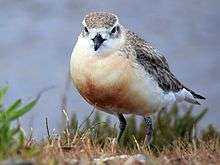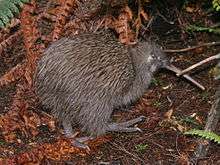New Zealand plover
| New Zealand plover | |
|---|---|
 | |
| Scientific classification | |
| Kingdom: | Animalia |
| Phylum: | Chordata |
| Class: | Aves |
| Order: | Charadriiformes |
| Family: | Charadriidae |
| Genus: | Charadrius |
| Species: | C. obscurus |
| Binomial name | |
| Charadrius obscurus Gmelin, 1789 | |
The New Zealand plover, red-breasted plover, or New Zealand dotterel (Charadrius obscurus) is an endangered species found only in certain areas of New Zealand. Its Māori names include tūturiwhatu, pukunui, and kūkuruatu. There are two subspecies, C. o. obscurus in the South Island and C. o. aquilonius in the North Island. A 2015 study found its closest relatives to be other plovers found in New Zealand, the nearest the wrybill (Anarhynchus frontalis), which the study found to be in the Charadrius clade, and then the double-banded plover or banded dotterel (Charadrius bicinctus).[2]
New Zealand plovers are shorebirds and are usually found on sandy beaches and sandspits or feeding on tidal estuaries. In 1990 these birds were nearing extinction with about 1300 northern dotterels, and about 75 southern dotterels, but conservation measures were effective in raising these numbers to 1700 and 250 respectively by 2005.
Breeding
Parents lay eggs in the spring and summer. They nest on beaches above the high tide mark, and the nest is just a shallow hole dug in the ground, not made of twigs like a nest in a tree. The chicks hatch about 28 days after the eggs have been laid. Because the nests are on the ground, chicks can walk the day they hatch and can usually fly within 6–8 weeks.
Status
The southerly subspecies, (C. o. obscurus) is now only present on Stewart Island at the southern end of South Island and in 1990 its numbers had reduced to about 62 individual birds. Conservation measures were put in place involving the poisoning of feral cats and the population has gradually risen, with about 250 individuals being recorded in 2005. The northerly subspecies (C. o. aquilonius) has a wider range at the northerly end of the North Island and its population was about 1300 in 1989. It had recovered to about 1700 individuals by 2004 but only as a result of intensive management. The IUCN rates this bird as "Endangered".[3]
Gallery
- Mature male
 Eggs
Eggs Illustration of chick
Illustration of chick
References
- ↑ BirdLife International (2012). "Charadrius obscurus". IUCN Red List of Threatened Species. Version 2013.2. International Union for Conservation of Nature. Retrieved 26 November 2013.
- ↑ dos Remedios, Natalie; et al. (2015). "North or south? Phylogenetic and biogeographic origins of a globally distributed avian clade". Phylogenetics and Evolution. 89: 151–159. doi:10.1016/j.ympev.2015.04.010.
- ↑ "Species factsheet: Charadrius obscurus". BirdLife International. Retrieved 2013-12-17.
External links
| Wikimedia Commons has media related to Charadrius obscurus. |
- New Zealand dotterel/tūturiwhatu Department of Conservation
- J.E. Dowding; A.M. Davis (2007). "New Zealand dotterel (Charadrius obscurus) recovery plan, 2004–14. (Threatened Species Recovery Plan 58)" (PDF). Department of Conservation, Wellington, New Zealand. Retrieved 2007-09-03.

